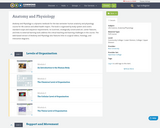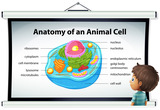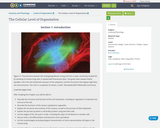
17 Results


Anatomy and Physiology is a dynamic textbook for the two-semester human anatomy and physiology course for life science and allied health majors. The book is organized by body system and covers standard scope and sequence requirements. Its lucid text, strategically constructed art, career features, and links to external learning tools address the critical teaching and learning challenges in the course. The web-based version of Anatomy and Physiology also features links to surgical videos, histology, and interactive diagrams.
- Subject:
- Anatomy/Physiology
- Life Science
- Material Type:
- Full Course
- Provider:
- Rice University
- Provider Set:
- OpenStax College
- Date Added:
- 07/23/2019

- Subject:
- Anatomy/Physiology
- Life Science
- Material Type:
- Unit of Study
- Provider:
- Rice University
- Provider Set:
- OpenStax College

All living beings are made up of cells. Some of them are made up of only one cell and others have many cells. Also in: Dutch | French | Hungarian | Spanish
- Subject:
- Biology
- Life Science
- Material Type:
- Activity/Lab
- Game
- Lesson Plan
- Provider:
- Arizona State University
- Provider Set:
- Ask A Biologist
- Author:
- Dr. Biology
- Shyamala Iyer
- Date Added:
- 09/25/2009

Students color-code a schematic of a cell and its cell membrane structures. Then they complete the "Build-a-Membrane" activity found at http://learn.genetics.utah.edu. This reinforces their understanding of the structure and function of animal cells, and shows them the importance of being able to construct a tangible model of something that is otherwise difficult to see.
- Subject:
- Applied Science
- Biology
- Engineering
- Life Science
- Material Type:
- Activity/Lab
- Provider:
- TeachEngineering
- Provider Set:
- TeachEngineering
- Author:
- Amber Spolarich
- Date Added:
- 09/18/2014

This interactive lesson can be used by students to learn or review and practice animal and plant cell structures and function.

In this unit, students look at the components of cells and their functions and discover the controversy behind stem cell research. The first lesson focuses on the difference between prokaryotic and eukaryotic cells. In the second lesson, students learn about the basics of cellular respiration. They also learn about the application of cellular respiration to engineering and bioremediation. The third lesson continues students' education on cells in the human body and how (and why) engineers are involved in the research of stem cell behavior.
- Subject:
- Applied Science
- Biology
- Engineering
- Life Science
- Material Type:
- Full Course
- Provider:
- TeachEngineering
- Provider Set:
- TeachEngineering
- Date Added:
- 10/14/2015

Structure of the endoplasmic reticulum and Golgi body (Golgi apparatus). Their role in protein secretion. Created by Sal Khan.
- Subject:
- Biology
- Life Science
- Material Type:
- Lesson
- Provider:
- Khan Academy
- Provider Set:
- Khan Academy
- Author:
- Sal Khan
- Date Added:
- 01/07/2014

The theory of how mitochondria, chloroplasts and other membrane-bound organelles in eukaryotic cell likely arose from a symbiosis between aerobic prokaryotes and host anaerobic eukaryotic ancestors. Developed by Lynn Margulis.
- Subject:
- Biology
- Life Science
- Material Type:
- Lesson
- Provider:
- Khan Academy
- Provider Set:
- Khan Academy
- Author:
- Sal Khan
- Date Added:
- 09/26/2018

Introduction to extranuclear inheritance (part 1).
- Subject:
- Applied Science
- Biology
- Health, Medicine and Nursing
- Life Science
- Material Type:
- Lesson
- Provider:
- Khan Academy
- Provider Set:
- Association of American Medical Colleges
- Author:
- Efrat Bruck
- Date Added:
- 01/28/2015

This resource is a video abstract of a research paper created by Research Square on behalf of its authors. It provides a synopsis that's easy to understand, and can be used to introduce the topics it covers to students, researchers, and the general public. The video's transcript is also provided in full, with a portion provided below for preview:
"One of the hallmarks of eukaryotic cells is the presence of organelles. Because each plays a distinct role in cell health, organelles require unique sets of proteins formed in the outlying cytoplasm, which means each organelle must have molecular machinery for recognizing and importing these proteins. For proteins destined for the nucleus, “nuclear localization signals” (NLSs) facilitate this process. An NLS is a short amino acid sequence that signals “pickup” by nuclear transporters. In recent years, NLSs have been widely used in cancer treatment and the prevention of viral infection. The trafficking of proteins into the nucleus through NLSs is mediated by proteins referred to as “importins.” Classical NLSs (cNLSs) on cargo proteins are sequentially recognized by the importin α and β subunits and then shuttled into the nucleus through a series of steps. Nuclear proteins can also rely on non-classical NLSs (ncNLSs) that help them “piggyback” on other proteins that contain classical NLSs..."
The rest of the transcript, along with a link to the research itself, is available on the resource itself.
- Subject:
- Biology
- Life Science
- Material Type:
- Diagram/Illustration
- Reading
- Provider:
- Research Square
- Provider Set:
- Video Bytes
- Date Added:
- 10/13/2021

Students learn the function of the liver and how biomedical engineers can use liver regeneration to help people. Students test the effects of toxic chemicals on a beef liver by adding hydrogen peroxide to various liver and salt solutions. They observe, record and graph their results.
- Subject:
- Anatomy/Physiology
- Applied Science
- Engineering
- Life Science
- Material Type:
- Activity/Lab
- Provider:
- TeachEngineering
- Provider Set:
- TeachEngineering
- Author:
- Denise W. Carlson
- Malinda Schaefer Zarske
- Megan Schroeder
- Date Added:
- 10/14/2015

The structure and role of mitochondria (plural for mitochondrion). Outer membrane, inner membrane, cristae, porins, etc.
- Subject:
- Biology
- Life Science
- Material Type:
- Lesson
- Provider:
- Khan Academy
- Provider Set:
- Khan Academy
- Author:
- Sal Khan
- Date Added:
- 07/27/2015

Understanding the structure of plant cell walls.
- Subject:
- Biology
- Life Science
- Material Type:
- Lesson
- Provider:
- Khan Academy
- Provider Set:
- Khan Academy
- Author:
- Sal Khan
- Date Added:
- 07/29/2015

In this lesson, students use the app, Powers of Minus Ten Bone, to discover the innerworkings of cells and their organelles. Exploration of the app is guided with the use of a scaffolded worksheet as well as a class discussion. Later in the lesson, student groups are assigned a specific organelle and use the information contained in the app to draw similarities and differences between the buildings in a city to the organelles inside a cell. Students will construct a clay model of an organelle as well as a model of a city building. Finally, student groups are asked to present their work via a class presentation followed by a creative writing assignment.
- Subject:
- Applied Science
- Biology
- Health, Medicine and Nursing
- Life Science
- Material Type:
- Lesson Plan
- Author:
- Dr. Brinley Kantorski
- Margaret Elias
- Date Added:
- 04/15/2024

In this project, you will explore a real-world problem, and then work through a series of steps to analyze that problem, research ways the problem could be solved, then propose a possible solution to that problem. Often, there are no specific right or wrong solutions, but sometimes one particular solution may be better than others. The key is making sure you fully understand the problem, have researched some possible solutions, and have proposed the solution that you can support with information / evidence.Begin by reading the problem statement in Step 1. Take the time to review all the information provided in the statement, including exploring the websites, videos and / or articles that are linked. Then work on steps 2 through 8 to complete this problem-based learning experience.
- Subject:
- Biology
- Life Science
- Material Type:
- Lesson Plan
- Author:
- Bonnie Waltz
- Deanna Mayers
- Tracy Rains
- Date Added:
- 10/01/2017
